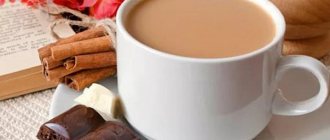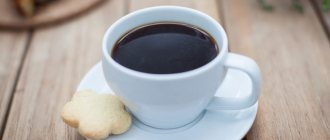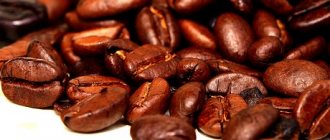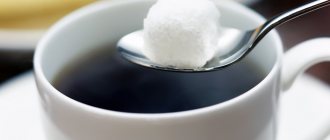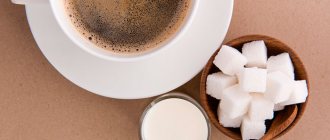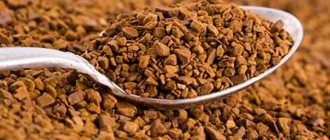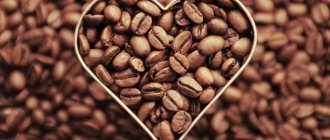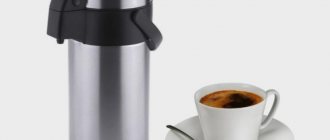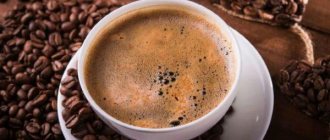Milk is the most popular additive in coffee. Most people prefer milk coffee drinks, as they are milder in taste and do not feel the bitterness or sourness of coffee. Any coffee shop has a huge selection of coffee and milk-based drinks, much more than pure black drink. Milk is poured hot and cold, whipped, and foam is made. Some add sugar, but most avoid it and drink their drinks as they are served. For those who control their diet, it is important to know the calorie content of coffee with milk without sugar.
How many calories are in coffee with milk without sugar?
There is no single exact number. Much depends on the volume and quality of the dairy product, and to a lesser extent on coffee. Coffee beans contain almost no calories, and the fats and sugars present are baked in when roasted. Soluble granules have a higher energy value, but they also cannot affect overall caloric intake as much as dairy products. Therefore, first we will consider the calorie content of milk of all types and types of fat content.
According to the standard, energy values are written on packages per 100 ml, but most people add about a tablespoon per cup (for a medium cup) or about 2.5 tablespoons for a large mug. You can use this data as a guide, or calculate exactly how much milk you pour into your favorite drink.
Calorie table for different types of milk
| Type of milk | Calories per 100 grams | Calories per 20 ml serving (tablespoon) | Calories per 50 ml (2.5 tablespoons) serving |
| Fat content 0.1% | 31 | 6 | 16 |
| Fat content 0.5% | 36 | 7 | 18 |
| Fat content 1.5% | 44 | 9 | 22 |
| Fat content 2.5% | 52 | 10 | 26 |
| Fat content 3.2% | 58 | 12 | 29 |
| Fat content 3.5% | 61 | 12 | 31 |
| Domestic cow | 64 | 13 | 32 |
| Dry whole | 476 | 95 | 238 |
| Dry low fat | 350 | 70 | 175 |
| Soy 0.1% | 28 | 6 | 14 |
| Soy 0.6% | 43 | 9 | 22 |
| Condensed without sugar | 75 | 15 | 38 |
Let's calculate the total calories
Now let’s just mix all the ingredients in one container and calculate how high-calorie the prepared drink is. For convenience, we will compile a table of several options for combining products. When calculating, we use the calorie content of one gram of each component:
- ground coffee – 2 kcal;
- milk (2.5% fat) – 0.5 kcal;
- sugar – 3.9 kcal.
| Option No. | Number of products | Total calorie content, kcal | ||
| Coffee, g | Milk, ml | Sugar, g | ||
| 1 | 2,5-4 (1 tsp) | 20 | 5-7 (1 tsp) | 34,5-45,3 |
| 2 | 10-14 (2 tsp) | 54-72,6 | ||
| 3 | 50 | 5-7 (1 tsp) | 49,5-60,3 | |
| 4 | 10-14 (2 tsp) | 69-87,6 | ||
| 5 | 5-8 (2 tsp) | 20 | 5-7 (1 tsp) | 39,5-45,5 |
| 6 | 10-14 (2 tsp) | 59-80,6 | ||
| 7 | 50 | 5-7 (1 tsp) | 54,5-68,3 | |
| 8 | 10-14 (2 tsp) | 74-95,6 | ||
The discrepancy in the final amount is due to fluctuations in the weight of coffee powder and sugar: a teaspoon without a slide and with it. Milk with a fat content of 2.5% was used in the calculations. With a different number of incoming ingredients and other products, the calorie content of a cup of coffee with sugar and milk will change. In this case, you will have to recalculate taking into account the new data.
Calorie content of natural coffee with milk without sugar
Coffee beans have a low energy value - on average, 2-4 kcal per 200 ml of finished drink. If you add milk from a carton or tetra-pack, add 2-4 calories per serving of dairy product and you will get a fairly accurate number.
Example: we brew 200 ml of coffee in a Turk, this is 4 calories. And add 50 ml of milk with 1.5% fat - that’s another 22 kcal. A 250 ml cup of drink produces 26 kcal.
The difference of +/- 5 calories for one drink made from natural grains does not play a role in a daily diet of 1500-2000 kcal.
But quite often we drink coffee with milk in coffee shops, in the form of ready-made drinks, and the amount of milk in them varies. As a rule, coffee shops purchase milk with a fat content of at least 3%, and more often - 3.2% or 3.5%. It produces an elastic, durable foam of a pleasant color that holds well. The foam from a low-fat or medium-fat product is often grayish and falls off quickly. 3.5% milk gives a delicate, creamy taste, and it is usually chosen for coffee shops, also used for those drinks where the milk does not need to be frothed.
Difficulties in counting
Let’s make a reservation right away: it is impossible to make an absolutely accurate calculation of the calories received from one cup. People prepare this drink according to different recipes and volumes, but most often its composition has several ingredients:
- water;
- coffee (ground, instant);
- milk (cream);
- sugar.
These components are most often added arbitrarily. Some add a little sugar to taste, others like a very sweet drink or prefer to drink it with honey. The amount of milk added and its fat content can vary greatly, and some people prefer cream. Therefore, such calculations are approximate and are always made with a reservation, with an exact list of additives and their volumes (weight).
Everyone can calculate the energy value for themselves, knowing the list of ingredients and their quantities. After all, you are preparing a drink according to your own recipe, which is slightly different from the classic one. But the final figure will be approximate, since no one accurately measures the added products in milliliters and grams. Although the accuracy can be neglected if you drink no more than 2-3 cups per day. A difference of about 10 kilocalories will not play a big role.
Types of coffee drinks: how much milk and calories they contain
As a rule, milk coffee drinks are prepared on the basis of espresso, single or double. Different chains have their own recipes and volumes of the drink, and therefore the calorie content. The table below presents popular drinks from well-known chain establishments.
| Name of chain and type of drink | A portion | Calorie content |
| Coffeemania Cappuccino | 330 | 90 |
| Coffeemania Cappuccino | 450 | 160 |
| Coffeemania Latte | 330 | 156 |
| Coffeemania Latte | 450 | 218 |
| Coffeemania Flat White | 430 | 130 |
| CoffeeHouse Double Cappuccino | 100 | 64 |
| CoffeeHouse Latte | 100 | 44 |
| Chocolate Cappuccino | 100 | 35 |
| Chocolate Latte | 400 | 220 |
| Chocolate Cappuccino Light | 320 | 125 |
| Starbucks Cappuccino Grande | 350 | 140 |
| Starbucks Latte Grande | 350 | 220 |
| Starbucks Latte low fat | 350 | 112 |
| Starbucks Cappuccino low fat | 100 | 20 |
| McDonalds Cappuccino | 300 | 123 |
| McDonalds Latte | 300 | 132 |
Calorie content of main types of coffee
The calorie count of coffee varieties depends on the preparation techniques and composition:
| Type of drink | Calorie content of a standard serving (kcal) |
| Latte | 180-200 |
| Cappuccino | 120 |
| Mocaccino | 250-289 |
| Glyase | 100-200 |
| Mocha | 330 |
| Frappuccino | 400-420 |
| In Irish | 114 |
| Raf | 85 |
| Frappe | 400-450 |
| A la Pompadour | 200 |
| Espresso | 4-7 |
Calorie content of instant coffee with milk without sugar
Instant granules themselves are much higher in calories than natural grains. The fact is that during their production, only 15-20% of natural grain remains, the rest are emulsifiers, thickeners, dyes, stabilizers, impurities and the like. The taste also changes noticeably. And that's why most people add more dairy to instant coffee than to natural coffee to remove the chemical tastes of bitterness or acidity.
If you use powdered milk, keep in mind that it significantly increases the calorie content! 70-90 kcal in one tablespoon!
On average, we can assume that one teaspoon of soluble granules or powder contains about 10 calories. Some manufacturers have 4-5 (Nescafe), some have about 20 (Tchibo). You can find the exact information on the packaging, but if this is not possible, calculate based on 10 kcal per serving. Add to this the amount of milk product that you add - for a large mug it will be about 50 ml, for a small one - about 20.
Example: you prepare 250 ml of Carte Noire, add 2 heaped teaspoons, you get about 20 grams of granules, that is, about 20 calories. And add 50 ml of milk 2.5% fat - another 26 calories. In 300 ml of the finished drink you have 46 kcal.
What can you do to reduce the calorie content of your drink?
I would like to say that you need to add fewer additives, but this will change the recipe and lead to a different taste of the drink. Therefore, it is better to switch to less fatty ingredients and sweeteners or make smaller portions. For half a standard cup, you can add half the amount of food, get the same taste, but fewer calories. Perhaps you will like this option more, you will enjoy the taste more slowly and with less harm to the body.
Conclusions:
- Dairy products contain 1.5-3.5% fat - 10-12 kcal per tablespoon. A natural drink has about 4 kcal per 200 ml, and instant coffee has about 10. It’s easy to calculate the average calorie content.
- In coffee shops, a latte has more calories than a cappuccino, because milk with at least 3% fat content is used, and a latte has more of it.
- The more dairy product (milk, foam) in a cup, the more calories you will get.
- If you prefer natural coffee, you don’t have to count calories per cup - there are no more than 4-6, which is almost insignificant for the overall diet.
Last sip
We determined that the maximum energy value of coffee with sugar and milk is about 95.6 kcal. Most of the calorie gain came from supplements. But some gourmets also like to include honey, special syrups, toppings, alcohol, ice cream, spices, nuts and other ingredients in the drink. Such coffee will be much higher in calories, so individual calculations will be required in each specific case.
Reducing the energy intensity of dessert is achieved by reducing portions, using low-fat milk, and sugar substitutes. But this is only relevant for people watching their weight. For other readers, these materials will be needed only as an introduction and broadening their horizons, if they do not drink 7-10 cups a day of a highly sweet drink with heavy cream. For ordinary coffee lovers, 2-3 servings of the invigorating composition will not have a negative impact on health.
Useful properties and indications
Contrary to popular belief that coffee with milk is extremely harmful, it also has beneficial properties. These include:
- Tonic effect. Due to the high caffeine content in the drink, it stimulates the nervous system, promotes concentration, and relieves symptoms of apathy and drowsiness.
- Favorable effect on the gastrointestinal tract. Coffee with milk helps speed up digestive processes and improve the functioning of the stomach and intestines.
- Prevention of various diseases. Regular consumption of the drink helps reduce the risk of developing pathologies such as myocardial infarction, type 2 diabetes, Parkinson's disease, Alzheimer's disease and some others.
The drink has a beneficial effect due to its rich composition. 100 g of coffee with milk and sugar contains 4 daily carbohydrates, 2 fats and 3 protein. Also includes:
- Vitamins: B, A, C.
- Milk fat.
- Antioxidants
- Microelements: calcium, iodine, sodium, magnesium, phosphorus.
The properties and taste of the drink also depend on the method of its preparation. In addition to instant coffee, the following are deservedly popular:
- Latte. It is prepared from natural beans with the addition of frothed milk, which should be 3 times more than coffee.
- Cappuccino. This drink, on the contrary, contains 3 times more coffee than milk.
- Macchiato. A three-layer drink consisting of milk, coffee and foam.
The most useful option is considered to be one that contains more milk, because black coffee helps remove calcium from the body, and milk is the main source of this microelement.
Calorie content of coffee (per 100 grams of product)
| Coffee type | Calories, kcal | Squirrels | Fats | Carbohydrates |
| Granular, soluble | 94 | 15 | 3,5 | 0 |
| In beans | 223 | 13,9 | 14,4 | 15,6 |
| Ground | 201 | 13,9 | 14,4 | 4,1 |
So, these are the indicators of the raw materials. Let's calculate the required values.
As you can see from these data, the lowest calorie coffee is granulated (see how freeze-dried coffee is made). Until now, many people continue to drink this drink. On average, take 2 tablespoons of coffee for one 200 ml cup. In our case, one spoon is approximately 8 grams of raw material.
As a result, we get 15 grams for one finished mug.
Conclusion - 1 cup of instant coffee contains about 14 calories
Go ahead. Let's calculate how much energy a mug of drink made from beans or ground coffee will give us.
For calculations, we will again take 2 spoons of raw materials per cup. These indicators are adhered to in most recipes - for Turkish coffee (see Oriental coffee), in coffee machines, etc. Accordingly, we will need 15 grams of coffee. We carry out simple calculations and get the result.
Conclusion.
A cup of whole bean coffee has about 33 calories. A cup of ground coffee - about 30.
You can see other indicators in the table. What can be noted. Natural bean coffee can be safely consumed before sports training (see why it is not recommended to drink a lot of coffee). They contain proteins necessary for muscle growth, as well as carbohydrates that saturate our body with energy. This is a completely acceptable energy drink.
But we completely forgot about sugar. If you add it to a ready-made drink, then add 30-32 calories per spoon. If we add 2 teaspoons to our coffee beans, our drink will end up containing about 100 calories.
Now you have everything you need for the calculation.
Other coffee additives
Milk is the most common, but not the only ingredient that can be used in the process of preparing a black drink. Many people add condensed milk, cream, ice cream, and much more. Let's see how many calories they contain and add that data to our calculations. We will take average indicators as a basis.
Chocolate (syrup)
Per 100 grams of product - 149 kcal. A teaspoon - 10 kcal.
Cream 10%
Per 100 grams of product - 100 kcal. A teaspoon - 10 kcal.
Condensed milk
Per 100 grams of product - 295 kcal. A teaspoon - 29 kcal.
Ice cream
Per 100 grams of product - 124.2 kcal. A teaspoon - 12 kcal.
Calorie content of coffee drinks
We will talk about drinks that are prepared for us using coffee machines, such as espresso. These are used in cafes and restaurants, fast food outlets, etc. Below are the caloric content of ready-made drinks, without added sugar.
| Name | Volume (grams) | Calorie content (kcal) |
| Americano | 450 | 15 |
| Latte | 450 | 250 |
| Cappuccino | 150 | 210 |
| Moccaccino | 450 | 290 |
| Glasse | 450 | 125 |
| Frappuccino | 450 | 400 |
| Coffee 3 in 1 | 200 | 70 |
| Rough coffee | 150 | 135 |
You can always do the calculations yourself.
Let's take latte coffee as an example. To prepare a 250 ml serving, you need 15 grams of ground coffee and about 100-150 ml of milk. If we add 2 tablespoons of sugar, we get a drink containing about 140 kcal.
It all depends on the specific recipe and the volume that we want to get in the end. For example, in a cafe you can choose from drinks ranging from 30 to 500 ml. Accordingly, the final indicators will vary greatly.
